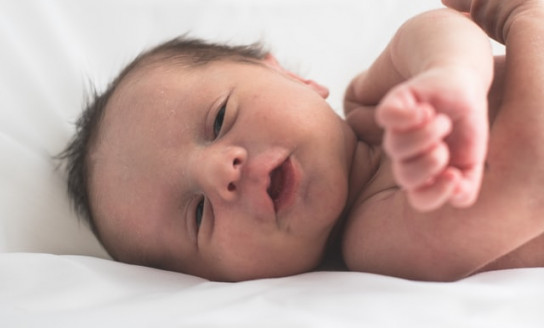Babies use sounds and movements to communicate with you from the moment they’re born.
A newborn’s cry is one of the main ways to let you know they need something. They also use:
- sounds – cooing and babbling
- facial expressions – eye contact, smiling, grimacing, mouth movements
- gestures/body movements – moving their arms or legs in distress or excitement.
To help you figure out what they might need, spend time watching them to learn how they show you they’re hungry, tired, uncomfortable or are wanting to play.
Baby states
As you get to know your baby, you’ll notice there are times when they’re alert and active, times when they’re watchful but quiet, and times when they’re tired and grumpy.
Getting to know these sleep and wake states may help you understand what your baby is likely to be needing or wanting.
Babies move through six different states:
Sleep states
Deep sleep
In a deep sleep your baby will:
- lie still with eyes closed
- breathe steadily and regularly
- be hard to wake up
- sometimes make jerky or sucking movements.
Babies in deep sleep need rest and a comfortable and, if possible, familiar place to sleep.
Light sleep
In a light sleep your baby will:
- have their eyelids closed but they may flutter
- make rapid eye movements under the lids
- make sucking or face movements
- may make a sleep smile
- wake more easily.
Babies in light sleep need time to wake or drop back into a deep sleep.
Drowsy/dozing
In the drowsy state your baby will:
- have heavy-lidded eyes which may flutter or look glazed
- make smooth body movements but may startle suddenly.
In the drowsy state just before waking, your baby may enjoy a cuddle while they wake or they may want to fall back to sleep.
Awake states
Quiet alert
In the quiet alert state your baby is ready for interaction. Your baby will:
- be wide eyed with a bright face and a still body
- be interested in your face and voice
- focus and be interested in what’s going on.
This is the best time to play and interact with your baby. In the quiet alert state your baby may like to take some time to watch before engaging. Give lots of time and watch for baby’s cues.
Unsettled
In the active alert / unsettled state your baby may:
- fuss and be unsettled
- move, wriggle and squirm a lot
- make thrashing movements with arms and legs
- be especially sensitive to loud noises and light.
Babies in an unsettled state are likely to need a change of pace. They may need a feed or just a slowing down because it is all too much.
Crying
In the crying state your baby may:
- cry intensely and be difficult to comfort
- change colour and yell.
Babies cry for lots of different reasons. Crying is their way of showing you what they need or are feeling. They may be tired, hungry, thirsty, too hot or cold, bored, scared, lonely or feeling sick. Soon you’ll be able to tell one cry from another, and that’ll help you know what to do.
Young babies move from one state to another very quickly, and not always in the same order. It helps to understand these states so you can think about what your baby might need at that time.
What your baby’s trying to tell you (baby cues)
Over time you’ll get to know your baby’s cues, and what different cries mean. Here are some of the common things your baby might be trying to tell you.
When they want to connect with you, they might do things like:
- turn their head towards you
- cry
- make eye contact with you
- smile
- coo or make other little noises
- move their arms and legs
- look interested.
When your baby is tired or needs a break, they might:
- cry
- yawn or close their eyes
- get grumpy,restless or unsettled
- pull away
- look away
- clench their fists
- have rigid, jerky arm and leg movements.
If they’re hungry, they might:
- cry
- nuzzle around the chest of whoever’s holding them
- smack or lick their lips
- suck hands, tongue, fingers, clothing, etc
- open their mouth and turn their head
- fidget or squirm around
- clench their fingers or make a tight fist over their chest or tummy.
When you respond to their cry quickly and in a loving way and help them by meeting their need, it helps your baby develop an understanding that when they ask for help, they’ll get it. They’re learning trust, and that they're loved, cared for, and can rely on others.
